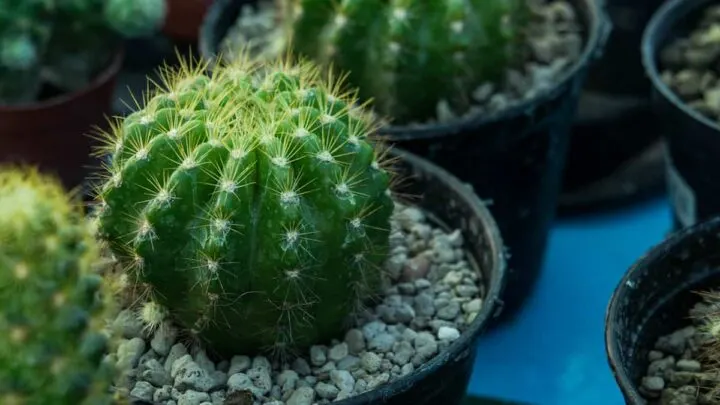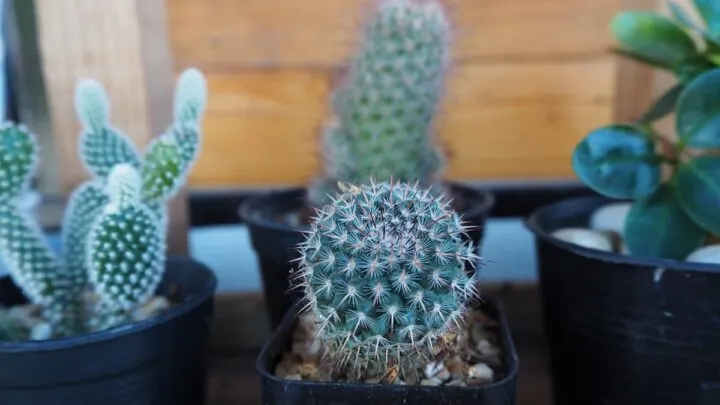The cactus is a truly unique plant that can survive in the most extreme of conditions. Cacti do not only need much less water than other plants need to survive, but their process of photosynthesis is slightly different as well. Plants’ breathing is an important part of that process, but how do cactus breathe?
Cactus breathe through photosynthesis. This allows the cactus plant to breathe in carbon dioxide and then release that as oxygen.
These abilities help the cactus thrive in extremely severe heat and drought. This article will explain how cacti breathe and how they can thrive in such hot and dry climates.

Do cactuses breathe oxygen?
No, cacti do not breathe in oxygen. Rather, they breathe in carbon dioxide. This carbon dioxide is taken in by the plant to be used in the photosynthesis process. The cactus then release oxygen as a result of photosynthesis. In a sense, cacti inhale carbon dioxide and exhale oxygen.
Does Cactus Breathe CO2?
Yes, cacti breathe in carbon dioxide, or CO2, during photosynthesis. This is done to help produce glucose in the plant. The plant then uses this glucose for fuel that allows them to survive, grow, and reproduce. The plant then gives off oxygen as a result of this process.
Does a cactus need air?
Yes, a cactus does need air. However, cacti do not need air in the same way that breathing animals do. This is because cacti and other plants breathe in carbon dioxide instead of oxygen. Carbon dioxide is available in the air, a key component for a plant’s survival. As a result, cacti do need air for their carbon dioxide, but they do not need oxygen in the air.

Do cactus roots breathe?
No, the roots of a cactus do not breathe. Rather, the stem of the cactus is what actively takes part in photosynthesis. This makes cacti unique because it is one of the only plants undergoing photosynthesis in its stem.
Most other kinds of plants do all of their photosynthesis in their leaves. However, cacti do not have the luxury of having soft green leaves. Instead, cacti have evolved to do their photosynthesis processes in their stems because delicate leaves cannot handle the intense heat and lack of water that the desert landscape provides.
The roots of the cactus do two things for the plant. The first function of roots is to help anchor the plant to the ground. This prevents the plant from becoming damaged by things like wind. The second function of roots is that they absorb ground water. Water is essential to every plant, even if it does not need to be watered regularly.
Do Cactus Release Carbon Dioxide At Night?
Cacti do not release carbon dioxide at night, but they inhale it and release oxygen at night. This part of photosynthesis is done at night in cacti because it helps the plant avoid losing too much water. This is important for cacti because of the intensely hot hours of the day in the desert.
Do Cactus Purify Air?
Yes, like all plants, cacti do help to purify the air. This is because, during their photosynthesis process, cacti take in pollutants like carbon dioxide, which effectively removes them from the environment. Then, these pollutants are replaced with clean and fresh oxygen. This is, again, thanks to photosynthesis.

Things To Consider
There are some additional things that you may want to consider when it comes to how cacti breathe. These things include knowing how cacti can survive in extreme conditions and why cacti need such little water to survive. Here are some other things for you to consider about cacti.
How Do Cacti Survive Such Extreme Conditions?
Cacti have evolved to survive the extreme conditions of deserts. This includes being able to survive intense heat as well as thrive with very little water. In fact, most cacti kept in homes and gardens are more likely to be over-watered than under-watered.
A thick stem with spikes and no leaves allows the cactus to survive in the desert environment much better than most other kinds of plants. In addition, cacti have evolved to conduct photosynthesis in their stems and hold a large amount of water for use later on. These evolutions have allowed cacti to survive better and even thrive in the harsh desert.
Why Do Cacti Need Such Little Water?
It is no secret that cacti need very little water to survive. There are a couple of reasons why cacti can survive without much water.
The first reason is that cacti, and most other kinds of succulents, have a very shallow root system. This allows the plant to absorb water quickly, even if there is very little rainfall.
Once the water has been absorbed, the cactus then holds the water in its stem. This can be done because the stem of the cactus has a large reservoir for holding water. Over time, the cactus will pull water from this reservoir as the plant needs. This allows the cactus to survive through long periods of drought.

Hi there, my name is Allie and welcome to my blog; GareningWithAllie!
Much of what you see written here is just our personal experiences with gardening. Along with the content I write here, there is also a unique collection of gardening topics covered by some of our close friends. I hope you find everything you read here to be helpful, informative, and something that can make your gardening journey the most lovely experience ever! With that said, Happy Gardening!
